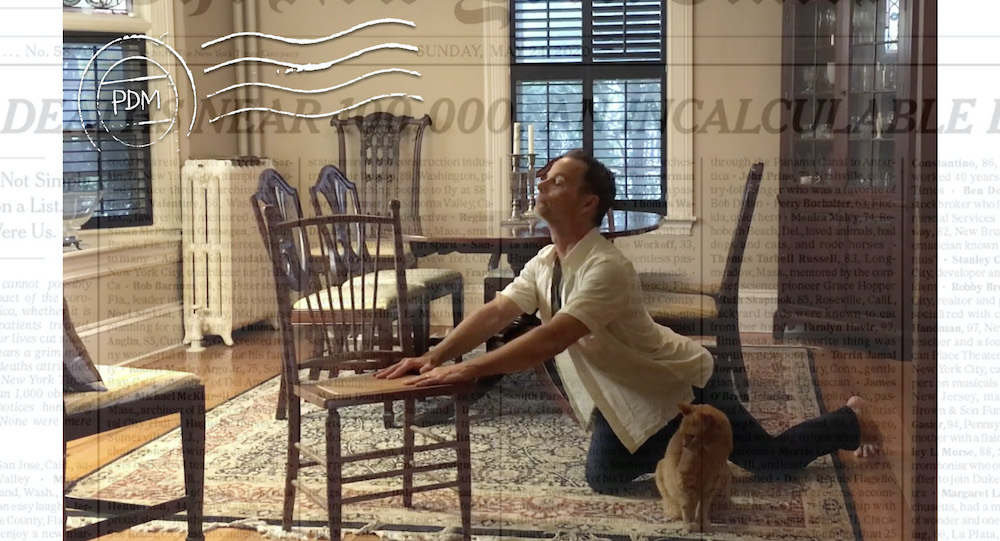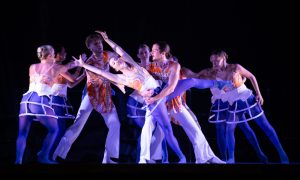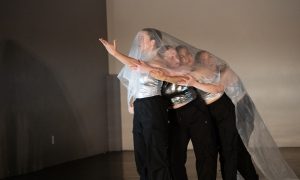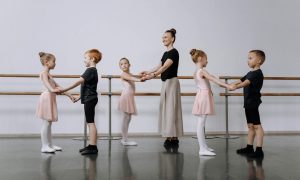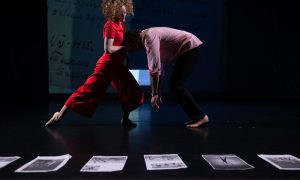Available at www.publicdisplaysofmotion.com/postcards-from-the-front.html.
Full program premiered on March 23, 2021.
COVID has surfaced questions about who and whose stories we value — or don’t value — in our society. They banged pots and pans at 7pm in New York City, and sang from their balconies in Italy — all to honor healthcare workers and others keeping society afloat through a pandemic. Yet, when the resonance of that sound fades, do we truly raise up the voices of those who give so much just so that we can all stay fed, healthy, educated and our spirits lit up?
Boston-based Peter DiMuro/Public Displays of Motion did just that through multi-disciplinary dance art, in virtual format, with Postcards From the Front. The company sought written testimonials from frontline workers — healthcare workers, teachers, those providing essential supplies, and artists (yes, artists, those considered “non-essential” through this time, many would attest erroneously so) — the “postcards from the front”. That writing became creative fodder for dance making, released over social media — postcard by postcard — and then finally as a complete program on the company’s website.
Many of the works were filmed in intimate home spaces, and from that have a domestic feel. In the opening postcard, for example, a tea kettle steams in the corner throughout. Ann Fonte dances to the words of Kara Danas, a youth community worker at the Boys and Girls Club of Greater Lowell, who describes how the simple act of sharing a meal with those in need can mean more than words can fully express. The movement in these postcards centers gesture over “virtuosity” — or rather, it’s a different kind of virtuosity, a pliability of the body to movement full of ingenuity and layers of nuance.
Kara Fili, her back to the camera throughout, moves forward and back — as if pulled multiple ways through the uncertainty — to a song by Rob Flax about waiting, love and distance from the person loved. Fili reaches tentatively but pulls back, a gesture that can resonate through the hearts of those craving unhindered human connection.
Lonnie Stanton repeats a movement phrase as the spoken score from Joanna Stumper, occupational therapist in Adolescent Group Homes, describes challenges of just getting by day by day when attending to the needs of young people. She sits on a high ledge, underscoring the sense of “stuckness”, of being constrained by the monotony of daily difficulty.
To the story of Emergency Room Physician’s Assistant Courtney Peerless, Matthew Cumbie dances in a bathroom. He moves with soulful commitment but simplicity in movement. It all builds a striking intimacy — the intimacy inherent in fighting for a patient’s life along with them.
Angelina Benitez and Rebecca Lang move with a sense of commitment and resolve even through the fear, anxiety and confusion of it all. Their connection at particular points align with how the postcard writer, Physician Ann McCaffery, focused on the relationships in her life at the end — truly the most important part of it all.
One section, set to excerpted readings from The New York Times’ “Gratitude in Six Words, From Our Readers” names what a variety of respondents are grateful for. To these words, Dean Vollick moves slowly and expansively through the space, as if soaking in all of its small wonders.
Olivia Blaisdell’s graceful, memorable pole dance solo spotlights a lesser-represented, misunderstood, and sometimes even stigmatized dance form. Blaisdell dances to the words of an anonymous Labor and Delivery Nurse based in Pennsylvania. Lindsay Caddle LaPointe dances to the words of Pediatric Oncology Nurse Grazie Baruzzi, moving with an unsettled quality — but just as much determination — over a colorful dinosaur pillow and amidst stuffed animals. All context considered, this imagery of childhood is both heartwarming and heartbreaking. Baruzzi recounts how amidst the stress and uncertainty, she finds strength from the “tiny heroes” she cares for each day.
Ann Brown Allen dances to the words of grandmother and Nursing Assistant Sarah Goor — with distance and a sense of sharp separation from elements of the space around her. Moor describes having to stay six feet away from her grandchildren for fear of infecting them. With personal sacrifice so clear and so great, it’s heartbreaking in a strikingly poignant way.
Working by an intriguing and moving concept, Kristin Wagner and Tony Guglietti dance in water — cleansing as soap and sanitizer does. As they move, distillery owner Brenton MacKechnie of Dirty Water Distillery and Nick Giannotti, bartender at Davio’s, describe making sanitizer from their alcohol supply.
The Davis Sisters (Alex Davis and Joy Davis) move together, Joy outdoors and Alex dancing onstage and seen in a cut-out square behind Joy. Throughout, Kristin Wagner speaks to her niece, recalling being called “non-essential” as an artist. Her sister, Courtney Peerless, then speaks to the same child, her child. They both describe how the child has kept them “tethered” to joy and goodness through this hard time. Although also with an ease and curiosity as they explore the space around them, Alex and Joy move with their own sort of tethering through a weighted connection to the ground beneath them.
A lovely ending postcard has Irene Letts dancing with shots interspersed of various “postcards” — illustrating unity and common experience amongst all of the postcard writers. She moves to “Nearness of You”, which brings to mind for me how we’ve all had to redefine what nearness means and how we can treasure that through this past year and change. When we are truly near again it can be all the sweeter.
When that time comes, thoughtful and moving works like Postcards From the Front can encourage us to keep in mind what really matters, and who sacrifices for the good of all. Brava and thank you to Peter DiMuro/Public Displays of Motion for that important encouragement. Art can move us forward, if we’re open to what it has to say.
By Kathryn Boland of Dance Informa.


